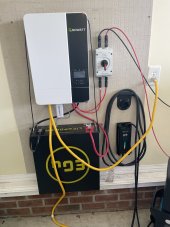Simple Level 1 Growatt SPF3000TL LVM-ES with EG4 Lifepower4 battery (3ft 2awg battery cables) with guest appearances from a Zencar level 1/2 adjustable EVSE and my Anker 767/760 that I use for an energy dump when I'm not home. Six URE 365 watt panels wired in series with 20 amp inline fuse and 10 awg MC4 cables.
This has been working very well for over a month now. On a sunny day I can put 35 miles in my Leaf. I have the system plugged into my garage outlet but I have it set to only charge from solar. Growatt/EG4 communication works well. Growatt wifi was a PIA to setup but has worked well ever since. Growatt/EG4 purchased from Signature Solar and their support has been pretty good thus far.
Planning to upgrade the Growatt output cord from 12awg to 10awg so I can turn up the amperage. I typically charge at 12amps(1440 watts) and the 12awg doesn't even get warm.
I also have some Q cell 480 watt bifacial panels I plan to integrate along with a couple more EG4 batteries along with breakers and fuses for a multi battery setup.
I've actually been pleasantly surprised at how well this simple system works. I can even run with batteryless with grid assist. Big thanks to Will for showing how simple it is to build something like this and to Steve from Reel Clear Media Youtube channel for his forward thinking inspiration. (He was doing this years ago)
This has been working very well for over a month now. On a sunny day I can put 35 miles in my Leaf. I have the system plugged into my garage outlet but I have it set to only charge from solar. Growatt/EG4 communication works well. Growatt wifi was a PIA to setup but has worked well ever since. Growatt/EG4 purchased from Signature Solar and their support has been pretty good thus far.
Planning to upgrade the Growatt output cord from 12awg to 10awg so I can turn up the amperage. I typically charge at 12amps(1440 watts) and the 12awg doesn't even get warm.
I also have some Q cell 480 watt bifacial panels I plan to integrate along with a couple more EG4 batteries along with breakers and fuses for a multi battery setup.
I've actually been pleasantly surprised at how well this simple system works. I can even run with batteryless with grid assist. Big thanks to Will for showing how simple it is to build something like this and to Steve from Reel Clear Media Youtube channel for his forward thinking inspiration. (He was doing this years ago)
Attachments
Last edited:





